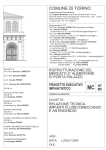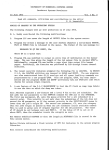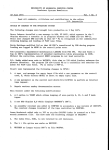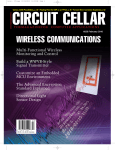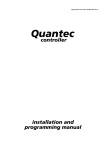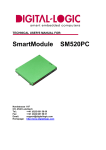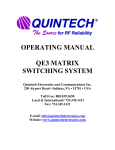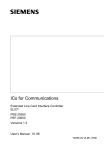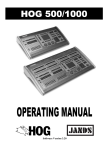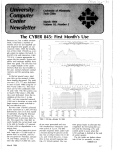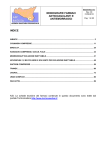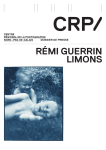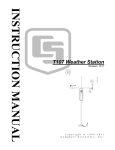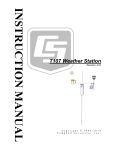Download v04n18 - Digital Conservancy
Transcript
----·
UNIVERSITY OF HINNESOTA COHPUTER CENTER
Deadstart Systems Ne\o~sletter
26 September 1978
Vol. 4, No. 18
Send all comments, criticisms and contributions to the editor: T. W. Lanzatella
University Computer Center, 2520 Broadway Drive, Lauderdale, MN
55113
The University of Hinnesota is an equal opportunity educator and employer.
TABLE OF CONTENTS
. • • • • 144
NOTICE OF CHANGES TO THE SYSTEM. •
• 145
PROPOSED CHANGES TO THE SYSTEM • • •
• 145
MSADR REVERSED - J. L. Larsen
SYSTE~1
• 146
HAINTENANCE • • •
LAST WEEK'S SYSTEMS GROUP MEETING - T. W. Lanzatella.
CALLPRG AND LIBRARY TAPE NEWS - M. Riviere. •
REMOVABLE PACKS AT UCC - J. J. Drummond • • • • •
A MULTI-PRIMER- W. J. Elliott • • • • • . • • • • •
COMPUTER RELATED TERMS USED IN DOCUMENTATION - A. B. Hickel
WHY WE SHOULDN'T ••. -A. B. }tickel • • . • • • • •
CYBER 74 DEADSTART D~W ANALYSIS - K. C. Hatthews •
6400 DEADSTART DUMP ANALYSIS - R. A. Williams • • •
..
..
....
....
....
..
146
146
147
147
150
151
154
156
NOTICE OF CHANGES TO THE SYSTEM
The following changes will occur on Thursday, 28 September.
Tom Lanzatella repaired an error in RESEX processing of multiple equivalenced
VSN's wherein the last VSN of an equivalenced VSN list appears in the preview
display after the first event expires. At this site we only display the first
VSN of an equivalenced VSN list. Tom also altered the account closed message
to instruct users to call Judy Krieg instead of Jim Foster.
John Larsen installed a yet to be proposed new option for HSADR which provides
the ability to convert from a physical to logical disk address.
Jim Hundstock installed a change to
routine when a ~ru unit is present.
COHC~1VE
which improves the speed of the
Kevin Hatthews altered several routines by installing another iteration toward
common queues. Kevin also repaired an error in the PF utilities (PFU, PFDUMP
and PF LOAD) which caused disk equipment to be occasionally turned off.
Don Nears again repaired lCD so that a 7600 code will not print. Don also
installed an important facet of the shared queue facility, that is the ability
for U1R to generate an Inactive Queue File Track (IQFT). Shared queues can
now be recovered across deadstarts. Additionally, Don added code to EXPORT
(actually lHS) which will cause the routine to abort gracefully rather than to
hang the system.
-144-
Brian Hanson added a correction to LINK which repairs the notorious RANDOM
ADDRESS NOT ON FILE SYSLIB bug.
Marisa Riviere corrected an error in CALLPRG processing of MID option on the
CALLPRG index entry.
Tim Hoffmann contributed an initial version of the CPU portion of the AUTODIVERT
facility - now called SITEVAL. Program SITEVAL performs site validation.
Jeff Drummond contributed the following changes.
1)
New versions of the console games LUNAR, LUN, STARWAR, WAR, KAL and lUC
were added to MPLNOS.
2)
A new console game DPR was added to NPLNOS. This game translates the CPU
P-register into display coordinates and generates a display from this data.
3)
Program ACCFAM was repaired so that when the ILLEGAL USER ACCESS message
is output, a monitor call error does not result. This occurred because
the message was within five words of FL.
~)
The common deck COMCRDC was altered so that a READC request will skip to
end of line if the working buffer fills up. (This mod was not proposed
and cannot be fully tested. - ed.)
5)
All "FET too short" situations in RESEQ.were eliminated.
6)
Program CATLIST was altered so that EP is set in the FET before calling PFM.
This change repairs the situation where i f a CATLIST request is issued for
a removable pack when the pack is not mounted, the job bombs with RESEX
FAILURE. A CATLIST request will now cause the job to roll just like any
other PFH requef?t. See J~illuminating article later in this newsletter.
7)
Jeff
8)
Jeff added a new (unproposed) option to CATLIST (PD) which causes the
report to be printed at 8-lines per inch •.
9)
Jeff repaired an error in PFILES wherein error messages were not being
reported if a PW option had been specified.
alte~~YSCOM
by adding a LINQ symbol for 8-lines per inch printing.
System procedure files U, K, DF and A were all changed in preparation for the
demise of pack STF.
No KRONOS change will be installed this week.
PROPOSED CHANGES TO THE SYSTEM
HSADR REVERSED - by J. L. LARSEN
A need has been indicated for the control card HSADR to produce the logical
address given the physical parameters.
This proposal, therefore, suggests that the HSADR control card be changed in the
following manner.
-145-
- The present control card reads:
MSADR,EQ=,T=,S=.
AQd produces the dayfile message:
Converted address UX CXXXX SXXXX.
Where the X's represent digits.
The new control card (which ~s the second option and is exclusive
from the above form) reads:
MSADR,EQ=,PU=,PC=,PT=,PS=.
And produces the dayfile message:
Logical address TXXXX SXXXX.
The default values of the parameters are:
Equipment EQ=<DI>
Physical Unit PU=<O>
Physical Cylinder PC=<O>
Physical Track PT=<O>
Physical Sector PS='<O>
Note: For the new control card to be recognized, one of the "P" parameters
must be present.
SYSTEM MAINTENANCE: - People and Procedures
Last Week's Systems Group Meeting- by T. W. Lanzatella
The following proposals were accepted or rejected • .
1)
Marisa Riviere's proposal to install a fast attach file manipulation utility
was approved after some discussion of the potential interlock problems (see
DSN 4, 17 p. 137). .
-
2)
Steve Collins proposal to add a parameter to relevant PFILE commands allowing
users to manipulate the UCW was approved (see DSN 4, 17 p. 138). The new
parameter will be UC=.
3)
Andy Bremanis' proposed new account file message was approved in principle
but rejected because the message was greater than 40 characters. Andy will
work with Tim Salo in devising a shorter message.
4)
Earl Schleske's proposal to add an assemblyoption to COMCRDW was accepted
(see DSN 4, 17 p. 139). Earl agreed to do the work.
5)
Steve Collins proposal to add CSET: NORMAL or CSET: ASCII to the STATUS
report was approved (see DSN 4, 17 p. 139).
Larry Liddiard announced that the employee appraisal forms are due by 1 October.
III/IIIII/
Callprg and Library Tape News - by M. Riviere
On September 21, the 6400 Library Tape was modified to include a new version of
MNFCLIB. This new version has some changes on the MANTRAP and FORSYS routines.
On September 21, the Cyber's Library Tape was restructured. Now this tape is
composed of three different files. A Cyber 74 only file, a Cyber 172 only file,
and a common file.
-146-
Current versions of SYSIO and COBOL5 w·ere placed_ on the Cyber 74 only section. New
versions of SYSIO and COBOL5 with DMS-170 interface are used on the Cyber 172.
These products were submitted by Steve Reisman. In addition, Steve added QUERY,
UPDATE, REPORT and DFRCV, a data base utility, an the Cyber 172 section of the tape.
Also on September 21, I largely modified the Callprg index in the Cybers. This
modification consisted of dropping the old KRONOS index section, rearranging
packages according to the programmers responsible for them, and removing the ones
no longer in use. I needed a lot of help from whomever was willing to contribute,
a lot of phone calls, and a lot of luck. The new version of Callprg ended being
almost right. Not perfect. Thanks for your help and patience, all of you.
In addition to the index reconfiguration, the following modifications took place:
Steve Reisman introduced DDL, a data base description language. DDL is a
package available only on the 172. Steve also rotated the versions of TRIAL
making future the current version and the current, past.
S. Yen inserted a new set of BMDP packages, BMDP77, and SIR a scientific
information retrieval system.
I inserted an entry to make accessible the 6400 Callprg index program library.
The entry is CPOPL64, fetch type. I also introduced an entry for PERT78.
PERT78 is a CDC product that I installed atM. Frisch's request.
I/ /IIIII!/
Removable Packs at UCC - by J. J. Drummond
This article summarizes the changes made to PFM, PFILES and CATLIST with regard to
removable pack requests. On a stock NOS 460 system, a permanent fil.e request
(such as CATLIST) for a file on a removable drive that wasn't mounted generated
a *RESEX FAILURE.* message unless the *NA* parameter was present. The *NA*
parameter caused the job to rollout and generated an operator request to mount
the specified pack. · Since our tape management system traps out requests for nonexistant packs, it was felt that jobs should always rollout for a removable pack
that wasn't mounted. This change was effected by setting the *NA* parameter
(error processing bit in the FET) in PFM if the file being accessed was on a
removable pack. However, this caused some unfortunate side effects since other
errors could occur and not be reported because the error processing bit was set.
Since PFILES already sets the error processing bit (to generate better looking
error messages and process the *WB* (wait busy) parameter), CATLIST was also
altered to set the error processing bit. The code to do this automatically was
then removed from PB1. This means that the CP programs doing permanent file
requests (PFILES and CATLIST) both set the error processing bit and do their own
error processing (as opposed to PFM setting the error processing bit and no
error processing being done). Staff who have programs doing internal permanent
file requests from removable devices should adjust their programs accordingly.
1/11/11/11
A Multi-Primer - by Bill Elliott, Minnesota Educational Computing Consortium
lvlULTI is a set of operating system routines and modifications which provide a
way for one copy of a program (called a task) to interact with several timesharing terminals simultaneously.
-147-
Since one job is executing for several terminals, file interlock and availability
problems disappear. Two-second response time is nearly always possible, even on
a loaded system. Programs which use the permanent file system for inter-terminal
communications would find the MULTI environment faster and more efficient. The
possibility of running some CAl programs in Multi-mode would be worth investigation.
A primary roadblock to faster response time is the speed at which jobs can be
moved to and from control points for execution. While jobs are waiting to be
executed, they are placed in a rollout queue. Jobs .are scheduled for execution
from this queue, on a priority basis, as memory becomes available. Rather than
speeding up this rolling process, MULTI reduces the number of jobs which need to
be rolled, and thus reduces system overhead.
Because one program executes for several terminals, the percentage of time spent
doing useful work is increased. This results in better response time for all
users, not only those in Multi-user mode.
"Task" is the name given to a program designed and compiled to be executed in
Multi-mode. Two classes of tasks exist: system tasks and user tasks. Task
execution begins by saving the task binary as a permanent file which is public
or explicitly permitted to UN=MULTI. To initiate Hulti-mode execution, one
types MULTI,TASKNAME for system tasks, or HULTI,TASKNAM,USERNUM for user mode
tasks. If the desired task is not present, ·i t is initiated by submitting a
job to the MU (Multi-user) job origin.
System tasks execute subject to validations for UN=MULTI. They may reside on
the DS Tape (if SSJ or other special permissions are necessary) or on a
permanent file (VIA CALLPRG, or special UN=SYSMU).
User tasks are executed in a sub-control point to prevent use of exotic RA+l
requests and excessive memory and PFM usage. Because of this, extensive error
diagnosis can be performed and the exchange package plus memory dump saved for
inspection.
Each task is a separate job functioning as any other job in the system except
that its queue priorities rival those of the HT origin and that CIO processes
read/write of its INPUT/OUTPUT file with a different overlay. The heart of
}lliLTI is the CIO overlay. All the rest of it merely gets things into position.
This means minimal TELEX overhead (600 words), minimal CPUHTR overhead (no
SIC functions used).
HULTI was designed to co-exist with TRANEX. However, since TRANEX has not
been available, we have been unable to check this out.
Tasks communicate with terminals through their INPUT and OUTPUT files. Text
and status information is placed into the task's input buffer by }lliLTI. Each
text line and status entry is separated by a control word. This control word
identifies the entry type (text or status), the terminal of origin and one or
two arguments. In some cases, there is no text to associate with the control
word~
In this case, a null text line is always supplied for consistency.
Possible status notifications which may appear in the input buffer are:
New User
Existing
Existing
Terminal
l\Fants to· Log Into Task
User Hung Up. the Phone
User Interrupted His Terminal (S or I _Key)
Ready for Hore Output
-148-
Based on the content of its input buffer, the task responds by writing to its
output buffer. As with the input file, each text line or command must be
prefaced by a control word. This control word designates the nature of the text
line following it (Text or Command), the destination terminal and one or t~o
arguments. Possible commands which may appear in the output buffer are:
Delink User from Task and Return to Telex Mode
Acknowledge Terminal Interrupt
Request Input from Terminal
Request Notification When Output Nearly Complete
:Casks do not execute more frequently than once in two seconds. As input becomes
available from terminals, it is transferred to the input buffer. When an
endfile status (030) is returned, no more text is available from the terminals
assigned to the task. The task should complete processing those input
directives and text which were provided, flush its output buffer and perform other
housekeeping functions before reading its input file again. A second read with
no data available will return another endfile status and roll the task out until
input text is again available and at least two seconds have elapsed.
On a machine language level, ta~ks differ widely from their program
The manner in which data are received fro~ the users (text prefaced
words) varies from the normal method (text separated by end of line
where the program is dedicated to the individual terminal. This is
counterparts.
by control
marker only)
to be expected.
Fortunately, it is possible to minimize this difference by providing common
decks and versions of·existing compilers to handle most of the bookkeeping. A
set of COMPASS common decks and a version of the BASIC and l1NF compilers have
been developed which will aid in the conversion of existing programs into tasks
which may then be executed in a Hulti-user environment.
All control bytes except the 0004 byte (log off user) are processed when operating
in Multi-user mode. User logoff can still be directed when the task issues a BYE
or HELLO as the logo~t text when it returns the terminal to the normal TELEX mode
of operation.·
Even with the aid of common decks and compilers, not every program can be
converted into a task. One must keep in mind the increased memory which is
required to maintain the status of each individual user on the task.
It is the responsibility of each task to internally GET or ATTACH those
permanent files required during the execution of the task. Tasks are permitted
only to GET, ATTACH and REPLACE permanent files. A limit of 10 permanent file
operations.is imposed.
Up to 64 terminals may execute a user task simultaneously. There is no upper
limit for system tasks. The task may enforce a limit of fewer terminals by
simply issuing its own apologetic message and returning the terminal to TELEX
mode. When a terminal is returned to TELEX mode, it is in the same state as
before .entering Multi-user mode. The subsystem and input mode (ASCII or NORMAL)
remains unchanged.
-149-
MULTI was developed at MECC to meet the demand placed on the system by a few
heavily used interactive programs. Current tasks include several demonstration
routines with a system MAIL and editor routine in the wings. A few users have
written their own tasks with more under development. MULTI has been well
received and is contributing to better response time this year for MECC users.
A special thanks to Bill Wells for his suggestions and guidance with the current
design. }lliLTI is brought to you courtesy of those Cin)famous }ffiCC systems programmers
Rick Nordin, Mark Rustad, and yours truly.
1111/11111
Computer-Related Terms Used in Documentation - by Andy Mickel
One of the by-products of the User's Manual project was to establish a unified
documentation scheme which would-make sense to the ordinary user. It is
heartening to see this unified documentation scheme firmly in place, functioning
and being carried forth by Mary Boyd and Sara Graffunder. A complete description
appears in Chapter 1 of the User's Manual.
Another by-product was a partial attempt to choose terms carefully in the User's
Manual. Now this should be linked to other documentation. It is important to
reduce the total number of terms and to discard those which can be potentially
confusing. Actu~lly, the list below was collected mostly by talking informally
with various people at UCC, particularly systems programmers at Lauderdale.
Cool (Like, wow-man!
Not So Cool (Out)
It's IN)
account number
user number
control card,
control statement,
job card,
job statement,
data cards,
data record,
job deck.
job file.
(To be general enough to cover submit batch jobs.)
7-8-9 6-7-9 6-7-8-9 cards
end of record, file, information
(All of the above correspond to current Control Data usage.
They prevent users from asking, "Where do I put the cards
into the teletype?")
timesharing
interactive
TELEX command
interactive command
(A much more accurate description of the mode of processing.
Batch jobs are "time-shared" too, thanks to swapping.)
unit record,
line
card image,
line
line-image.
line
(I know, I know, the Record Manager people will protest.
IBM/CODASYL terminology has pervaded their thinking so much, they
don't know a simple concept when they see one. Control Data's
solution at level 472 is to introduce a whole new set of different,
redundant, and confusing terms for Record Manager •.)
co~ed file
text file
(text files are stored in "binary" form too)
real-time programming
time-dependent programming
legal
valid, correct
illegal
invalid, incorrect
(Bucking a trend to allow lawyers from talking their way into the
computing profession; apologies to Pat Jarvis!)
-150-
1111///111
Why We Shouldn't Necessarily and Blindly Go To New Versions of NOS - or What Do tve Really Want From Our Operating System? - by Andy Mickel
During the first weeks of August while working furiously out at Lauderdale
helping with the NOS conversion effort, I saw on a blackboard, a half-erased
description of NOS (Network Operating System):
1.
2.
3.
4.
5.
6.
7.
8.
9.
Complexity
Obscurity
Unreliability
Dozens of character sets to choose from
New and interesting design flaws
Cyber Record Manager
Common Memory ~funager
NAH (Network Access Method)
Etc.
I would agree this is amusing because of the all-too-familiar ring of truth it
carries. Since the demise of KRONOS 2.0 in 1973, we have seen the operating
system, as produced by CDC, get a little more unwieldy with each release.
In switching to NOS, we have just completed the largest operating system change
since the MO}ffi-KRONOS conversion in Fall, 1974. Unlike the change to KRONOS,
which was well worth the effort (and was a lot of work), I feel like a lot of
other systems programmers that the recent conversion was only marginally worth
the effort. I found myself running very hard all year just to stay in the same
place. I'm tired, and what's worse, I still hadn't recovered fully from that
MOMS-KRONOS conversion four years ago! I certainly don't want to do it again,
and so I'm moved to invest some more time and effort into writing this essay.
I'm tired of the op.~rating system changing out from under me when the
expected benefits are outweighed by the magnitude of the disruption; I'm a
user too.
not everyone at UCC realizes the extent of the effort mostly put forth
by systems programmers (unsung heroes). Over 40,000 lines of locally-developed
code were converted. This is the code that tailors the bare-bones CDC system
to our site's needs (the features added are far too numerous to mention here;
the surest way to appreciate the difference·fu to log-in on a stock CDC system:).
}~ybe
Because of the modification scheme (the Minnesota Modification Method) we use
(which preserves a stock version of the operating system), we were able to
adapt these mods reasonably quickly and reliably. Contrast this to other sites
such as the University of Colorado, which has heavily modified its KRONOS 2.1
level 1 system (but not by using our modification scheme which makes anOPL
out of the mods themselves). This year they estimated it would take approximately
the same time to move to level 10 KRONOS (12 months) as it would to retrofit
the newer product set into the level 7 system.
Or cont'rast our situation with say, the University of Nevada or Stanford Research
Institute, for example. They are locked into KRONOS but have also bought NOS
(very expensive), not to run it, but must to steal code to put into KRONOS in
various places.
-151-
The point is that it should not be taken for granted that these conversion
efforts are accomplished without a lot of sweat and tears, and that we at the
University of Minnesota Computer Center are privileged to have an operating
system so flexibly maintained.
Why did we go to NOS?
Last December when we more or less decided to go to NOS, it was argued that
we needed to have: 1) Multi-Mainframe (MMF), 2) Full-Tracking Disks, 3) Transaction
Facility (TAF), 4) NAH 2550 support, and 5) the ability to run the new product
sets of the future. NOS 1.2 (level 3 or PSR level 460) only provided a couple
of these; most of the goodies come with later versions of NOS and so NOS 1.2 was
deemed our first step. Several of us argued against going to NOS but were
convinced by the conventional wisdom, and at least the NOS Conversion Task
Forces helped air out the issues. But we succeeded in converting to NOS 1.2 as
smoothly as can be expected plus having thrown in a few other "minor" changes
to boot (SRU accounting, new character set, etc.) by working very hard all
this year (from late December to present). Many of us are fatigued to say
the least.
And there is still talk of moving the whole system to NOS 1.3 (level 4, PSR
level 472 or correction level 477) within a year.
We no longer are compelled to go to NOS 1.3 and beyond.
Let's reassess the situation. We have full-tracking now thanks to Kevin
Matthe\vs who retrofitted it into NOS 1. 2. l\Te nearly have a MMF that fits our
needs (CDC sure doesn't make one) thanks to Kevin Hatthess, Jeff Drummond,
Don Hears, and others. We decided not to buy TAF.
NAM has been a can of worms from the beginning.
set. (:Hore on these two items in a moment.)
We don't need the new product
Two considerations should be made from now on for every across-the-hoard ·.
operating system change. 1) It is a struggle to write good user documentation
and then see it wiped out in a conversion. The Tape Guide is a case in point:
it must now be updated to reflect a few NOS differences at a time when we need
to spend our efforts writing documentation f.or other areas which have· never
been documented. "Part of the normal course of events," you say. Well it
just so happens we wouldn't have a Tape Guide if it weren't for a dedicated
programmer named Bill Elliott who could and did write user documentation. And
we don't have him now to fix it. Similar documentation examples can be cited
as well. 2) University users should be polled at least once a year (or before
a proposed change) to o~tain their judgments on what our software and ha~dware
improvements should be. As it is, they aren't even consulted, and if it
weren't for them, we wouldn't be here.
Back to NAM .!{How can· CDC sell a thing with a name like 'nam?). NAM has two
parts: Remote Batch Facility (RBF) and InterActive Facility (IAF) to replace
EXPORT (and SUPIO) and TELEX. Its reputation at VIM last year in Hinneapolis
caused reasonable people to froth at the mouth. NAM's liabilities when compared
with TELEX and SUPIO are that it consumes a large portion of central memory,
and performs badly in CP time. Releases fr·om CDC have been consistently l~te
in delivery.
-152-
Besides the CM portion of NAM, there's a front-end processor running in the
2550 which has a better reputation, and it is (*wow, gee*) written in Pascal.
But when Arnie Nelson showed me the Pascal code, the Pascal cross-compiler, and
the performance of same, I agree with him that it's a mess: Pascal transformed
into a bizarre perversion!
Let's look at the product-set argument. CDC is producing FTN ~ for the FORTRAN-77
standard. But FTN accounts for less than 10% of Fortran usage on our machines,
and this share is even shrinking. The new FORTRAN standard has few new useful
features if you listen to the FORTRAN experts, and the vast momentum of
existing FORTRAN IV programs will cause the new FORTRAN to be accepted slowly.
To counter FTN 5 we will have M77 to implement FORTRAN-77. Besides CDC has
insured that the FORTRAN common library will be unusable from MNF at level 472.
So what about COBOL 5 (implementing ANSI · 74 COBOL)? We already have it working
under NOS 1.2 (level 460). We won't need to change it.
What about maintenance, you ask? This is a case where it will be less disruptive
to the vast majority of users to retrofit the new product set into the operating
system (if there really is a need to acquire it) than to change the entire
operating system to fit a few products. The numbers are dramatic: .J ust looking
at languages, (there were also over 100,00·0 runs each of SPSS and S2000) MNF
and TSF had a combined use of 910,000 and Pascal 272,000 versus 81,000 for FTN
and 154,000 for COBOL. It's even a good bet that there aren't that many
FTN and COBOL users that use the new features anyway.
Another upcoming horror attached to the new product set is Common Memory Manager
which inhibits the very feature .it is supposed to enable: dynamic memory.
Further, it's another slower and bigger software system which would cause us
to lose another chunk of our machine.
So if CDC is leading us down the path to ruin, then why do we need to follow them?
We have shown for four years that we can ably maintain (document, etc.) a
heavily-modified operating system and even perfect it to the point of 100%
up-time in a month (something we never can do when we stay current with CDC). We
are planning to replace the Cyber 74 (with a good possibility of a non-CDC
machine) in a few more years and that means that the 172 or its replacement
would merely front-end the new, major system, so why would we need to run the
current CDC operating system then and afterwards on the lesser machine?
CDC seems to be imitating IBM more and more. First of all, they're making
money now and have discovered that they like this better than delivering costeffective computer systemS. Prices of manuals, maintenance, and software .
have soared. CDC has learned from IBM that if you produce operating systems
which consume more computer resources (mainly Central Memory and CPU), then
the customer will buy more central memory an4 CPU. CDC is incidentally naming
its software components with obscure three-letter abbreviations (as illustrated
by NAM, CMH; CRM, IAF, BAM, RBF, TAF, etc.) and CDC sales are using unfortunate
pressure tactics (they won't sell any other operating system besides-NOS or
NOS/BE to run on a 170). In short, they have degenerated unfortunately to IBM's
level. ·
-153-
What are our goals for our computer system?
I think we'd all agree that we want to provide the most reliable, cost-effective
computing possible to the University community and then to outside users. And
we should strive to make the computer system simple to understand and thus to
use so that we open it up to more people, not less.
Why then do we feel compelled to follow CDC's software mistakes which are now
running contrary to cost-effective computing? I refer to mistakes which are
software systems that: 1) most importantly make the computer system morecomplex and obscure and thus less simple to maintain, document, and to use,
and 2) consume computer system resources (run slower and larger). Example:
Record Manager. If it weren't for MNF and MSUIO, record manager would have
dealt a serious blow to the 6400's timesharing performance. Little things add
up. When you have to swap lOK extra for a dozen interactive jobs all·the time,
you've lost .!OK of your machine. Example: Cyber Loader - it's easily 50-100
times slower in loading absolute overlays and takes far more memory for any
kind of load. Make Cyber Loader default on MERITSS and you'll be looking up
at six fathoms of water. What has it done to the Cybers? We just lost another
chunk of our machine to overhead.
The conventional reply to all this is that Record Manager and Cyber Loader
provide features which were desirable and requested by CDC sites. My reply to
this is: "Fine, but I doubt that those features necessitated performance that
poor." If one can sum up recent advances in programming, it has been clearly
shown that there are much simpler ways of getting computing done. Software need
not be this complicated or inefficient.
Quite often contradictory arguments are given in system group meetings to
provide the rationale behind proposed changes to the system. Example: ·~e
want to add this feature to the system as a separate control statement so as
not to invalidate existing CDC documentation and to avoid altering a similar
program (e.g., CATLSYS vs. CATLIST)." In contrast: "ROUTE must be modified
to fit our needs; the X parameter will be made non-functional and the COPYAP
parameter will be added."
My opinion after watching us vacillate without a clear systems strategy for four
years is that it certainly depends on the individual case. But I feel we should
be less afraid to alter existing CDC programs (control statements)l, because the
plethora of redundant programs is proving to be harder to explain in general
documentation. We have demonstrated that with important programs like DISPOSE
and now ROUTE our local documentation is sufficient to describe the feature to
the user community in spite of the erroneous description remaining in the NOS
manual. We should take this course more often.
III/III/II
Cyber 74/172 Deadstart Dump Analysis from Monday, 11 September 1978 to Sunday,
24 September 1978 - by K. C. Matthews
Tuesday·, 12 September
16:40 (DD-17)
Export hung with no apparent activity.
Cyber 74
A level 3 deadstart was required.
-154-
21:10
Cyber 74
(DD-20)
Telex was down with lTA, lTD hung at the Telex control point.
Wednesday, 13 September
08:42
Cyber 74
Disk channel 27 hung up preventing a complete deadstart.
the problem temporarily.
12:00
(DD-21)
The engineers fixed
Cyber 74
PP program lSB hung at the Export control point. A level 3 deadstart failed,
and a level 0 was required. We have had several cases where it looks like a
level 3 recovery should have worked but didn't. This will have to be investigated.
12:19
(DD-22)
Cyber 74
CIO hung at a control point.
22 September.
The problem was analyzed and was corrected on
Thursday, 14 September
13:49
(DD-24)
CIO hung again.
-Cyber 74
Same problem as the day before.
Friday, 15 September
The Cyber 74 hung several times in the morning with problems on channel 27.
This problem was left over from Wednesday and was corrected.
15:05
(DD-50)
Cyber 74
The system hung. This dump has not yet been analyzed. There were many EXPORT
aborts around this time, however. The EXPORT problem was corrected by Don Mears
at 17:00.
Sunday, 17 September
22:55
(DD-15)
Cyber 74
lCJ hung. There was an old lCJ problem for which KCM's fix was bad.
fix is in on the current deadstart tape.
The real
Monday, 18 September
18:48
Cyber 74
(DD-2)
A disk error on deviceDN12 caused a job to hang up. The disk error was found
to be a solid flaw by L. Ozga and has been flawed out. We will have to investigate
why the disk error caused such a problem.
-155-
09:02
Cyber 172
(DD-31)
PP program lCJ hung.
previous day.
This was the same problem as on the Cyber 74 on the
09:19
Same problem as above.
Wednesday, 20 September
12:12
(DD-5)
Cyber 74
The same disk error as on Monday hung the Cyber 74.
13:11 (DD-6)
Cyber 74
The system hung.
This has not yet been analyzed,
Thursday, 21 September
15:08
(DD-7)
CIO hung.
17:55
Cyber 74
The old problem that was fixed the next day.
(DD-10)
Cyber 74
Same problem as above.
17:04
(DD-32)
Cyber 172
Monitor was hung.
This dump has not yet been analyzed.
Friday, 22 September
14:45
The power failed; all machines were down.
Up at 15:10.
1///11////
6400 Deadstart Dump Analysis (9/-11- 9/24) - by R. A. Williams
Date
780922
Description
A power failure caused the system to go down.
-156-
N.A.













